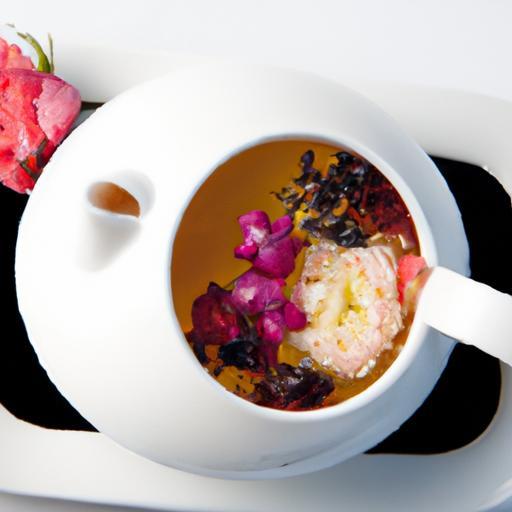There’s a quiet magic in the transformation of a blooming rose into a delicate, fragrant tea that soothes the soul. From garden to cup, the journey of drying roses preserves their beauty and essence, unlocking flavors that turn every sip into a floral embrace. In this guide, “Petal to Pour,” we’ll explore the art and science of drying roses perfectly-so you can steep your own little moments of calm, color, and aromatic wonder right at home. Whether you’re a seasoned herbalist or a curious beginner, join us as we unfold the petals and reveal the secrets behind crafting rose tea that’s as delightful to brew as it is to drink.
Choosing the Ideal Roses for Tea Worthy Petals starts with selecting the freshest blooms that boast vibrant colors and a fragrant aroma. The pink and red varieties tend to yield the most flavorful and aromatic dried petals, making your rose tea truly exceptional. Opt for organic, pesticide-free roses to ensure purity since these petals will steep directly in hot water. Early morning harvest on a sunny day gives the petals peak flavor and aroma, crucial for crafting the perfect cup.
Prep and Cook Time
- Preparation: 20 minutes
- Drying Time: 48 hours
- Brewing Time: 5-7 minutes
Yield
Approximate 10-12 servings of rose tea from 1 cup of fresh petals.
Difficulty Level
Easy to Medium – ideal for home tea makers venturing into floral infusions.
Ingredients
- 1 cup fresh organic rose petals (pink or red, pesticide-free)
- 4 cups filtered water for brewing
- Honey or agave syrup, optional for sweetness
- Lemon slices, optional for garnish
Instructions
- Prepare the roses: Gently rinse the rose petals with cold water to remove any dirt or residual insects. Pat them dry carefully with a clean towel to avoid bruising the petals.
- Dry the petals: Spread the petals evenly on a mesh drying rack or a clean, dry surface lined with parchment paper. Place in a cool, well-ventilated area away from direct sunlight to prevent color fading and loss of essential oils.
- Monitor the drying: Turn the petals every 12 hours to ensure even drying. The petals are ready when they feel crisp and brittle but retain their vibrant color and scent-usually within 48 hours.
- Store the dried petals: Place the fully dried petals in an airtight glass container away from heat and light to preserve flavor and aroma for months.
- Brewing the tea: Bring 4 cups of filtered water to a gentle boil. Pour over 1 tablespoon of dried rose petals in a teapot or infuser. Cover and steep for 5-7 minutes for an aromatic, delicate infusion.
- Serve: Strain the tea into your favorite teacup. Sweeten with honey or agave if desired, and adorn with a slice of lemon or a few fresh petals for an elegant touch.
Tips for Success
- Petal timing: Harvest just as the rose buds begin to open for maximum flavor intensity.
- Flavor preservation: Avoid overdrying to prevent bitterness; the petals should snap easily but not crumble to powder.
- Drying environment: Use a food dehydrator on its lowest setting if humidity is high, ensuring consistent drying without mold risk.
- Blending ideas: Mix dried rose petals with chamomile or green tea for nuanced herbal blends.
- Storage tip: Add a food-grade silica packet in your container to absorb moisture and prolong freshness.
Serving Suggestions
Present your rose tea in glass cups to showcase the warm pink hue. Garnish with a whole dried or fresh rose petal floating on top for a romantic, visually stunning experience. Pair this delicate infusion with buttery shortbread cookies or light lemon cakes to complement the floral notes. Serve at afternoon tea parties or as a refreshing digestive after a light meal.
| Nutrient | Per Cup (240 ml) |
|---|---|
| Calories | 2 |
| Protein | 0.05g |
| Carbohydrates | 0.5g |
| Fat | 0g |

Q&A
Q&A: Petal to Pour – A Guide to Drying Roses for Perfect Tea
Q1: Why should I consider drying roses for tea instead of using fresh petals?
A1: Fresh petals are beautiful and fragrant but contain a lot of moisture that can dilute your tea’s flavor or cause spoilage. Drying concentrates their aroma and taste, making each sip a more robust and lasting floral experience. Plus, dried petals keep longer, giving you a timeless stash for whenever the tea mood strikes.
Q2: What type of roses are best suited for drying and brewing tea?
A2: Choose roses that are organically grown or pesticide-free, with strong fragrance and vibrant petals. Varieties like Damask and Rosa rugosa are favorites due to their rich aroma and healthful properties. Avoid hybrid roses sold commercially for bouquets, as they often carry chemicals not safe for consumption.
Q3: How do I dry rose petals properly to preserve their flavor and color?
A3: Gently pluck the petals in the morning after the dew has evaporated. Spread them in a single layer on a clean, dry screen or parchment paper in a well-ventilated, shaded area away from direct sunlight. Let them air dry for about 7-10 days until they are crisp but not crumbly. Alternatively, use a dehydrator on low heat or an oven set to the lowest temperature for a few hours.
Q4: Can I dry whole rose buds for tea, or is it better to use just the petals?
A4: You can dry whole buds or loose petals – each offers a different experience. Whole buds tend to impart a subtler flavor and look charming when brewed, while loose petals release more intense aromas. Experiment with both to find your perfect pour!
Q5: How should dried rose petals be stored?
A5: Store dried petals in an airtight container away from light, heat, and moisture to maintain their delicate flavor and color. Glass jars with tight lids or resealable bags work well. Adding a small silica packet or dry rice sachet can help keep lingering humidity at bay.
Q6: What’s the best way to brew the perfect cup of rose tea from dried petals?
A6: Use about 1-2 teaspoons of dried petals per cup of hot (not boiling) water, about 190°F (88°C). Steep for 5-7 minutes to coax out the floral notes without bitterness. Strain and enjoy as is, or sweeten with a touch of honey or a slice of lemon for a refreshing twist.
Q7: Are there any health benefits associated with rose petal tea?
A7: Absolutely! Rose tea is packed with antioxidants, vitamin C, and anti-inflammatory compounds. It’s known to soothe digestion, relieve stress, and support skin health. While not a cure-all, it’s a gentle, fragrant addition to your wellness routine.
Q8: Can I blend dried rose petals with other herbs or teas?
A8: Yes! Rose petals harmonize beautifully with chamomile, lavender, hibiscus, and green or black teas. Such blends can create layered flavors and enhance the calming or invigorating effects. Let your creativity bloom with every blend!
Q9: How do I ensure the ethical use of roses in my tea-making?
A9: Harvest roses from your own garden or source from florists and growers who use organic, pesticide-free methods. Always avoid picking from public parks or wild areas where plants may be treated with chemicals or protected by law.
Q10: What creative uses are there for dried rose petals beyond tea?
A10: Dried petals can also elevate your culinary and self-care rituals: sprinkle them on salads, infuse syrups, craft fragrant bath sachets, or create natural potpourri. When life gives you petals, pour magic into every cup-and beyond!
Concluding Remarks
As the final petals fall into place, your journey from fresh bloom to fragrant brew is complete. Drying roses isn’t just a preservation method-it’s an alchemy that transforms vibrant blossoms into delicate teas brimming with flavor and history. With each sip, you’re savoring more than just floral notes; you’re embracing a timeless ritual that connects nature’s beauty with mindful moments of calm. So, whether gifted by spring’s first garden or gathered from a favorite bouquet, those dried petals hold the promise of rose-infused serenity-one perfect pour at a time.


